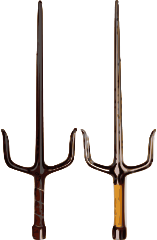On self-defense with a walking stick
Patrick over at Mokuren Dojo fired across an e-mail to me the other day about a post he wrote on tantojutso (a walking-cane adjunct to SMR jojutsu). Given the state of my stump at the moment (read more here), I’m currently using my walking stick where practical to get around the place, which meant Patrick’s post was eerily relevant to me 🙂
In 2008 I experimented with learning some stick fighting principles as an adjunct to my usual karate training. While the style wasn’t a strict or traditional one (despite some traditional aspects from the various systems present thrown into the mix), it was focused on some basic stick fighting principles, incorporating eskrima/kali elements with the rattan, bojutsu, defensive techniques with the hanbo and jo, a little bit of yawara training and a walking stick style that had its roots within a French system. The aim of the training was to give the practitioner the tools and principles to defend oneself by using any varietal of stick or pole as a weapon. I feel that, despite only spending a small period of time training in it, that it succeeded in teaching me some basic tenets for defending myself with varying weapons. While the eskrima stuff was probably the most fun (and made cool noises when training 🙂 ), the most relevant was arguably the walking stick techniques I learned.
The basic training showed how to use a hooked walking stick in a variety of ways. It demonstrated basic blocking and striking using various aspects of the walking stick, even down to utilising the different ends of the stick to achieve different ends. For example, if performing a thrusting strike, using the bottom of the stick concentrates the kinetic energy to a smaller surface of impact, giving rise to a variety of fast, poking strikes; however, depending on the walking stick, I found that this technique put excess stress on the shaft of the walking stick and required greater accuracy to achieve a worthwhile result. Going the other way, you can thrust using the hooked end of the stick, which is useful for creating more of a clubbing motion even when thrust. I found this to be quite effective given I found it quite intuitive to do a re-enforced two-handed thrusting strike with this technique from a utilitarian perspective, since I’ll normally have my hand on the hook and can easily use my other hand to grab the other end of the staff and use both arms for the strike. While the greater surface area means you get a different kind of impact than with the butt-end of the stick, it also requires less accuracy, which means it potentially has a greater degree of utility in a self defense scenario where the adrenalin or panic may hinder your usual level of accuracy.
What I found quite interesting is that it wasn’t too difficult to translate some of the broad striking motions and diagonal patterns of attack from eskrima to the walking stick. The difference of course is that a walking stick is generally longer than your average rattan… but that being said, if you’re familiar with short staff techniques (like jo or hanbo) and you have a longer walking stick, then you can also truncate your walking stick skillset with some of these other techniques (some of my favourite techniques from jo and hanbo were the trapping and joint-manipulation techniques, which I think would prove useful with a walking stick).
I guess it shows the level of inter-connectivity with different styles and the relationship between them. I have a feeling my Sensei would be pleased to know I joined the dots in my head and found the commonality in the tools he gave us 🙂
It also demonstrates a strong focus on utility (something that’s a core focus on the posts at The Martial Explorer) and that, as a martial artist, you should be able to not only demonstrate the finer aspects of the forms you learn in class, but be able to take away those core principles and utilise them as essential tools in any instances of self defense, or if we’re getting a bit more philosophical, utilise those precepts as an approach to everyday life.

 Image sourced from Wikimedia Commons, original image by chris
Image sourced from Wikimedia Commons, original image by chris 


